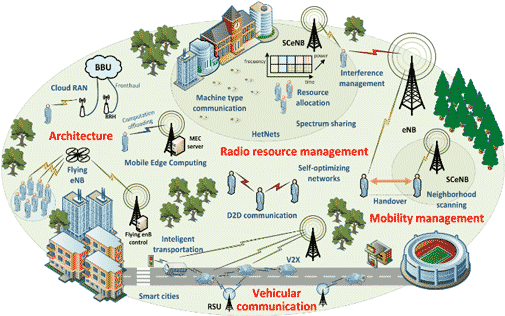Exploiting Mobile Edge Computing for Proximity Services
The vision of future 5G networks incorporates a heterogeneous communication environment in which existing radio access technologies (eg, 3G, 4G, WiFi) will be integrated with developing wireless technologies and systems, software-based network architectures and edge cloud-enabled facilities. The goal is to transform the user communication experience, enabling support for enhanced social applications, context-aware and proximity services, great service delivery, and high interactivity with smart and cognitive devices.
5G-AURA (Application-aware User-centric Programmable Architectures for 5G Multi-tenant Networks) is an Innovative Training Network (ITN) of the H2020 Marie Skłodowska-Curie Actions (MSCA), which aims to support the career development and training of young researchers through international and inter-sector mobility. This project is providing a programmable multi-tenant network architectural framework that can effectively harness the potential of innovative service-oriented network architectures supporting edge-cloud technology that will open the road for the enhanced user quality of experience, social application and proximity services. Virtualization and software defined networking will play a key role in supporting multi-tenancy and enabling the optimization and management of the network operation.
Mobile edge computing is being considered as a key enabler of 5G. It is a new technology which is presently being standardized in an ETSI Industry Specification Group. Mobile edge computing offers an IT service environment and cloud-computing capabilities at the edge of the mobile network, within the radio access network and in close proximity to mobile users. The aim is to reduce latency, ensure highly efficient network operation and service delivery, and offer an enhanced user experience. By exploiting edge-cloud computing capabilities, services and applications can react effectively to alternating radio conditions enhancing service differentiation, guaranteeing fast connectivity, reducing end-to-end latency and ensuring reliability. At the same time, edge-cloud computing can increase the network capacity provided that effective mechanisms for local edge caching, distributed storage, congestion control and reduced signalling are devised, while novel application interfaces from the edge-clouds towards the software defined networking controller.
Key objectives
- Exploring mechanisms that will allow the management of virtual machines at mobile-edge clouds, enabling programmable proximity services and social applications
- Investigating rapid cloud-based device discovery and location mechanisms based on the user subscribed applications
- Enabling new types of mobile-edge cloud assisted direct device services in order to optimize the network resource utilization and the user quality of experience
Expected outputs
- Establishing mechanisms to achieve rapid installation of proximity and social services close to the RAN using SDN mechanisms
- Developing application-aware cloud based discovery mechanisms taking advantage of the edge-cloud facilities
- Developing a new protocol for supporting device to edge-cloud communications for enabling efficient device tracking and thin client type of services related to social applications.


Members
- Mahmudul Haque Kafi
- Paul Mitchell
- David Grace
Funding
- European Commission: EU H2020 MARIE SKŁODOWSKA-CURIE INNOVATIVE TRAINING NETWORKS
Dates
- January 2017 to December 2019
